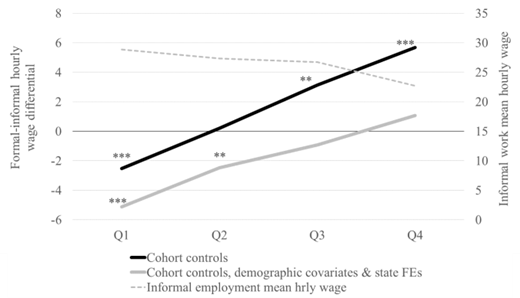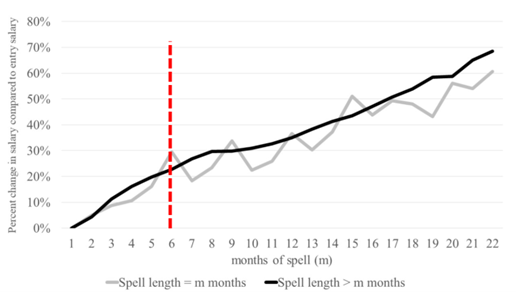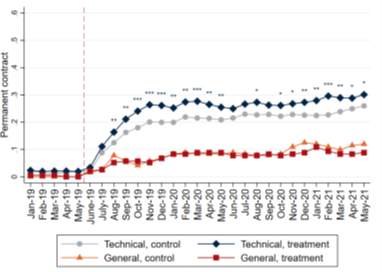Photo: Curt Carnemark / World Bank
Authors: Martin Abel and Eliana Carranza
This blog was originally published by and is reprinted by permission from VoxDev.
Imagine that you are an 18-year-old in Mexico, you have just graduated from high school and you plan to enter the labor market. Among the most important decisions is whether to start your career in the formal or in the informal sector. The latter are often easier to obtain and may offer advantages such as shorter commuting times and flexibility. In Mexico, they also offer a relatively high starting hourly pay that can be 9-17% higher in the informal sector than in the formal sector for youth aged 17 to 20 with upper secondary education. Therefore, you may choose informal employment as your entry point, especially if you are focused on short-term benefits.
However, this choice can have long-term adverse effects as informal work offers relatively static wages and rarely represents a step towards formality. On the contrary, formal wages grow substantially, by about 25% (35%) during the first six (twelve) months on the job. In addition, workers in the formal sector have other benefits, such as health and social security coverage.
Youth employment in Mexico
To address this problem, the World Bank, in collaboration with the Government of Mexico, conducted a pilot with students just about to graduate from 13 high schools in the metropolitan region of San Luis Potosí. The pilot granted an economic incentive paid directly to young people, equivalent to 20% of the average formal entry level wage, for up to six months, on the condition that they obtain and remain in formal employment.
The impacts of this wage incentive were assessed over two years, beginning in June 2019. The incentive increased formal employment among eligible vocational school graduates by 4.2 percentage points (pp) (14.5%), driven by a 5 pp (25%) increase in jobs with permanent contracts. Approximately half of this effect came from a reduction in informal employment. In addition, among youth with temporary employment contracts, the risk of leaving the job was 26% lower and the probability of transitioning to a permanent employment contract was 70% higher. In contrast, no effects were found among graduates of general schools. This is an important finding for policymakers who may be concerned about potential unintended negative consequences on youth’s decisions to further their education.
| Impacts of the wage incentive on employment, by school type
Share with formal work |
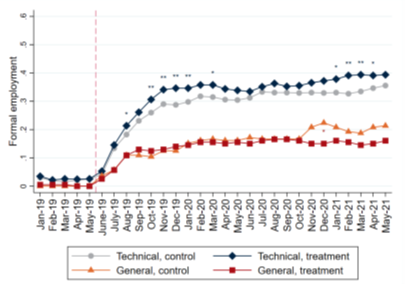 |
Formal jobs, especially those with permanent contracts, lead to an accumulation of human capital that benefits workers in developing countries where job turnover rates are high. In our pilot, even those youth who involuntarily switched formal jobs did not experience a drop in wages.
One explanation for why young job seekers do not pursue formal jobs that are more stable and remunerative in the long term but offer low starting wages, is their high “reservation wage”— the lowest wage level for which they would be willing to accept a job. This responds to the fact that, on the one hand, young people tend to significantly underestimate formal wage growth and, on the other, they value the present more than the future. Thus, providing them with information about the benefits of formal employment, including strong wage growth and social protection coverage, may not be enough.
|
|
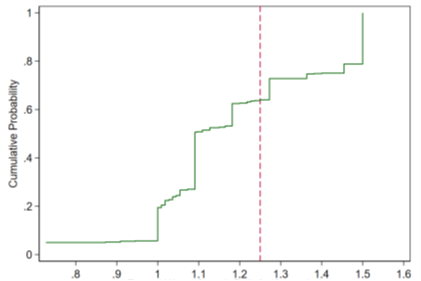 |
|
|
The wage incentive increases the immediate return that youths obtain in formal employment, nudging them to accept formal jobs that may initially pay less, but lead to a better salary and employment trajectory. So why don’t firms pay more to youths who are just entering the job market? The acquisition of skills on the job can help explain this. Since other firms can “poach” workers once trained, the first employer may be motivated to offer a (temporarily) lower pay, to offset initial losses associated with high job turnover, the costs of training young workers, and the higher costs of formal employment.
Indeed, social security deductions on wage income act like a tax on formal employment, while non-contributory social protection programs act as a subsidy to informal employment. It has been argued that this wedge may contribute to an oversized informal sector, which workers enter partly by choice. Lowering these deductions would raise the take-home pay of formal workers. According to our findings, a 20% increase in wages paid to young workers upon entering the labor market would raise formal employment by 10%, suggesting that a narrowing of the wedge would have considerable effects for less-skilled youth. in Mexico.

